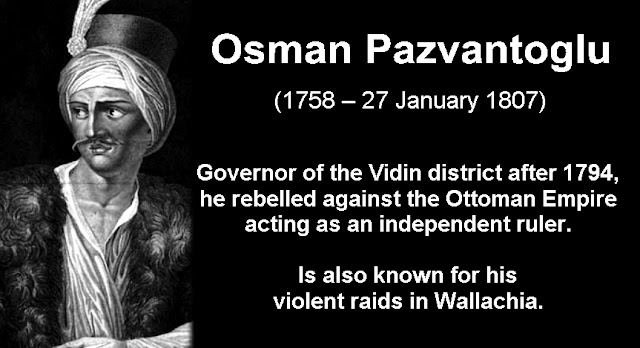Friday, April 7, 2023
Karadjordje and the First Serbian Uprising (1804-1813)
Djordje Petrovic, better known as Karadjordje was a Serbian revolutionary leader who fought for his country's independence from the Ottoman Empire during the First Serbian Uprising of 1804–1813.
Born into an impoverished family in the Šumadija region of Ottoman Serbia, Karadjordje distinguished himself during the Austro-Turkish War of 1788–1791 as a member of the Serbian Free Corps, a militia made up of Habsburg and Ottoman Serbs that was armed and trained by the Austrians. Fearing retribution following the Austrians' and Serb rebels' defeat in 1791, he and his family fled to the Austrian Empire, where they were to live until 1794, when a general amnesty was declared. Karadjordje subsequently returned to Šumadija and became a livestock merchant. In 1796, the rogue governor of the Sanjak of Vidin, Osman Pazvantoğlu, invaded the Pashalik of Belgrade, and Karadjordje fought alongside the Ottomans to quash the incursion.
The janissary commanders murdered the Ottoman Vizier Hadži Mustafa Pasha of Belgrade in 1801 and occupied the sanjak, ruling it independently from the Sultan. Tyranny ensued. The janissaries suspended the rights granted to Serbs by the Sultan earlier, and increased taxes, and imposed forced labor, among other things. The janissaries feared that the Sultan would use the Serbs against them, so they murdered more than 70 Serbian chiefs between 23 and 29 January 1804.
On 14 February 1804, in the small village of Orašac near Aranđelovac, leading Serbs gathered and decided to begin an uprising, choosing Djordje Petrović as their leader. The Serbs, at first technically fighting on the behalf of the Sultan against the janissaries, were encouraged and aided by Ottoman cavalry corps.
For their small numbers, the Serbs had great military successes, having taken Požarevac, Šabac and charged Smederevo and Belgrade, in quick succession. In july the janissary commanders fled east to Ada Kale, an island on the Danube. They refused to surrender, and were captured and beheaded, on the night of 5–6 August 1804.
The Sultan, fearing of the serbs power, ordered all pashaliks in the region to crush them. The first major battle was the Battle of Ivankovac in 1805, in which Karadjordje defeated the Turkish army and forced it to retreat toward Niš. The Serbs established a government and parliament that returned the land to the people, abolished forced labor and reduced taxes.
The second major battle of the uprising was the Battle of Mišar in 1806, in which the rebels defeated an Ottoman army from the Eyalet of Bosnia led by the Turkish Sipahi Suleiman-Pasa. Serbian rebels then joined the Russians as their allies in the Russo-Turkish War. The Battle of Deligrad in December 1806 provided a decisive
victory for the Serbs and bolstered the morale of the outnumbered rebels. To avoid total defeat, Ibrahim Pasha negotiated a six-week truce with Karadjordje. By 1807 the demands for self-government within the Ottoman Empire evolved into a war for independence backed by the military support of the Russian Empire.
Following the successful siege with 25,000 men, on 8 January 1807 Karadjordje proclaimed Belgrade the capital of Serbia.
In March 1809 Hurşid Paşa was sent to the Sanjak of Smederevo to put down the revolt. The diverse Ottoman force included vast numbers of soldiers from many nearby Pashaliks. On 19 May 1809 3,000 rebels led by commander Stevan Sinđelić were attacked by a large Ottoman force on Čegar Hill, located close to the city of Niš.
In a desperate situation, and not wishing for his men to be captured and impaled, Sinđelić fired into his entrenchment's gun powder magazine resulting in an explosion that killed all the rebels and Ottoman troops in the vicinity. Afterward, Hurshid Pasha ordered that a tower be made from the skulls of Serbian revolutionaries. Once complete, the ten-foot-high Skull Tower contained 952 Serbian skulls embedded on four sides in 14 rows. The Serbian defeat at Čegar Hill meant the loss of initiative in the war.
In August 1809 an Ottoman army marched on Belgrade, prompting a mass exodus of people across the Danube. Facing disaster, Karadjordje appealed to the Habsburgs and Napoleon, with no success.
With the reestablishement of Ottoman control, many of the revolutionaries, around a quarter of the population, including Karadjordje, fled to the Habsburg Empire. Recaptured by the Ottomans in October 1813, Belgrade became a scene of brutal revenge, with hundreds of its citizens massacred and thousands sold into slavery. Direct Ottoman rule also meant the abolition of all Serbian institutions and the return of Ottoman Turks to Serbia.
Despite Ottoman requests for his extradition, the Austrians handed Karadjordje over to the Russians, who offered him refuge in Bessarabia. There, he joined the Greek secret society known as Filiki Eteria, which planned to launch a pan-Balkan uprising
against the Ottomans. Karadjordje returned to Serbia in secret in July 1817, but was killed shortly thereafter by agents of Miloš Obrenović, a rival rebel leader, who was concerned that Karadjordje 's reappearance would cause the Ottomans to renege on the concessions that they had agreed to following the Second Serbian Uprising of 1815.












